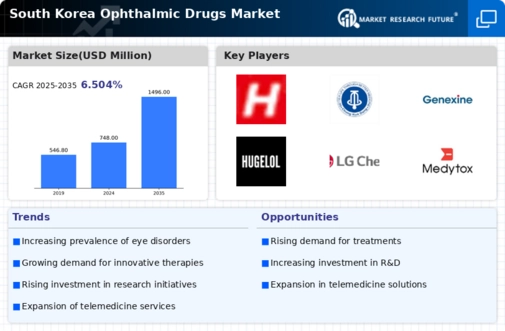The South Korea Ophthalmic Drugs Market is characterized by a dynamic competitive landscape driven by the increasing prevalence of ocular diseases such as glaucoma, age-related macular degeneration, and diabetic retinopathy. The market is marked by a strong emphasis on innovation and the development of advanced therapies aimed at addressing unmet medical needs in eye health. Key players are continually investing in research and development to enhance their product offerings, with a focus on formulations that provide better efficacy and safety profiles.
The competitive insights reveal a growing trend toward collaboration and strategic partnerships among firms as companies seek to expand their market share, enhance their product pipelines, and leverage synergies in manufacturing and marketing. The presence of well-established domestic players alongside international pharmaceutical giants adds to the complexity of the market, resulting in a diverse array of treatment options for patients.iSUN Pharma is a notable player within the South Korea Ophthalmic Drugs Market, focusing on developing innovative therapies for various ocular conditions.
The company has established a strong market presence through its robust product pipeline, which includes a range of ophthalmic formulations that cater to the needs of healthcare professionals and patients alike. The strengths of iSUN Pharma lie in its commitment to research and development, allowing the company to keep pace with advancements in the field. Its strategic collaborations with research institutions and other healthcare entities further bolster its position, enabling access to cutting-edge technology and expertise.
Additionally, iSUN Pharma's efficient distribution networks and strong relationships with healthcare providers enhance its market visibility and result in a solid reputation among ophthalmologists and patients.Hanmi Pharmaceutical has also carved a significant niche within the South Korea Ophthalmic Drugs Market, which is recognized for its comprehensive portfolio that addresses various eye disorders. The company boasts several key products and services that cater to diverse ocular conditions, contributing to a solid market presence. Hanmi Pharmaceutical's strengths include its commitment to innovation and the development of proprietary formulations aimed at improving therapeutic outcomes for patients.
The company has conducted strategic mergers and acquisitions to strengthen its capabilities and expand its footprint within the ophthalmic segment. These initiatives have not only enriched its product offerings but also positioned Hanmi Pharmaceutical as a key competitor in the market, with a focus on integrating cutting-edge research and enhancing patient access to high-quality ophthalmic treatments.



















